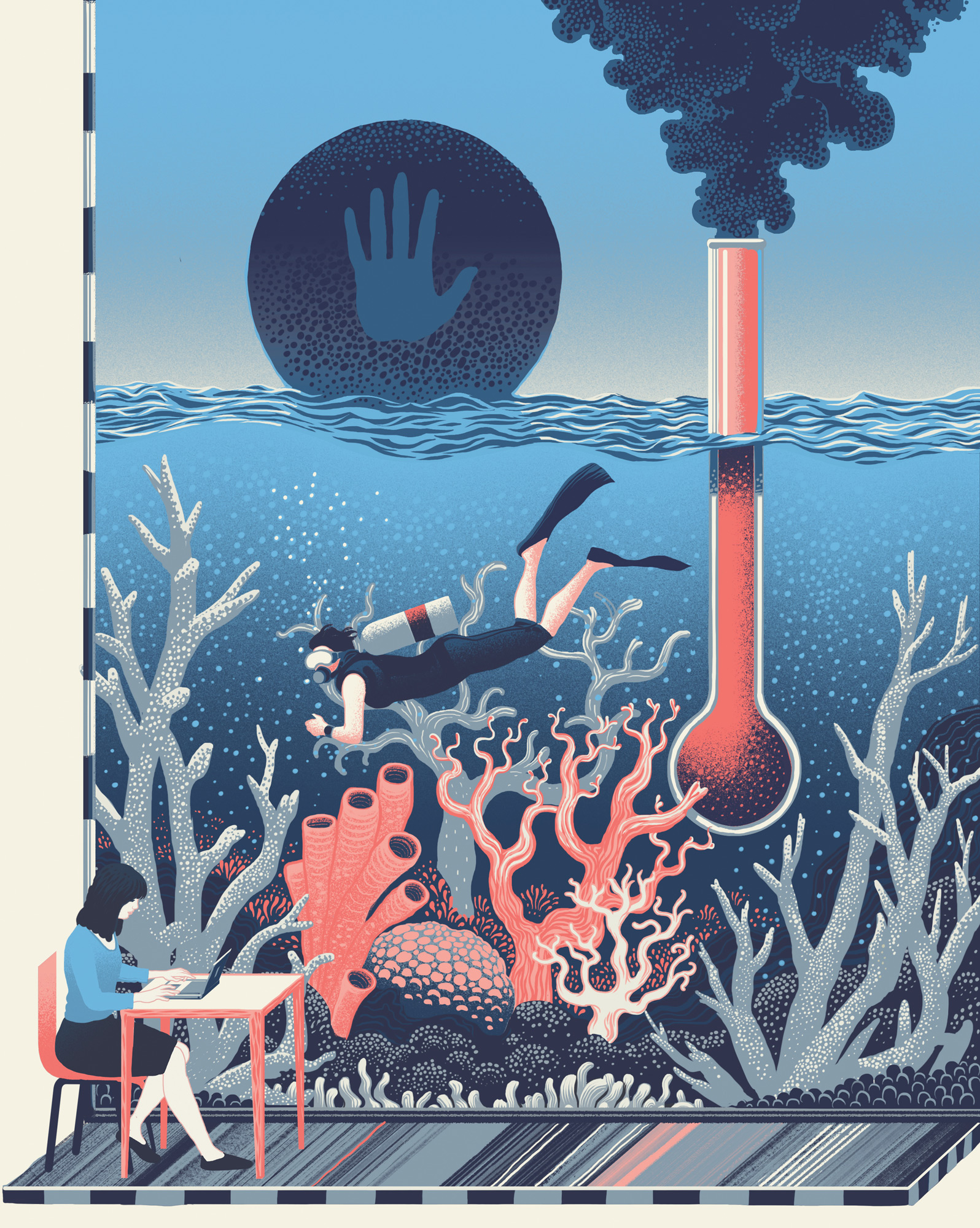A Race Against Time
Faculty from Penn Arts & Sciences are confronting the climate crisis and contributing to solutions. They say there’s still time to act.

Across the world and in Penn’s backyard, Arts & Sciences faculty are tackling challenges that touch directly or indirectly on climate change. In Hawaii, for instance, biologist Katie Barott is studying how corals respond to heat stress, while 5,000 miles northeast in Greenland, biogeochemist Jon Hawkings is looking at the impacts of environmental stressors on glacier ecosystems. Closer to home, in Philadelphia’s Fishtown neighborhood, a team that includes researchers from the Departments of Biology and Earth and Environmental Science (EES) is using fungus-derived materials to build bio-walls and playscapes that trap carbon and pollution from the atmosphere.
What makes the School’s climate-related work distinct is that much of it focuses on the effect on humans, says Michael Weisberg, Bess W. Heyman President’s Distinguished Professor. “Of course, we do interesting and important physical science,” he says. “But beyond that, the fact that much of our hiring and research has developed around the impacts to human societies is pretty unique.”
That includes the efforts of climate scientist Michael Mann, who joined Penn last fall as Presidential Distinguished Professor in EES and leads the newly launched Penn Center for Science, Sustainability, and the Media (PCSSM). It also encompasses the Environmental Innovations Initiative, established in 2020 and for which archaeologist Kathleen Morrison, Sally and Alvin V. Shoemaker Professor of Anthropology, is currently the faculty lead. The Initiative fosters collaboration through interdisciplinary research and, among other projects, has worked with each Penn school to establish Academic Climate Commitments.
On the heels of a summer marked by unprecedented flooding and sweltering heat, with ocean temperatures swelling to unheard of heights—reaching 101 degrees Fahrenheit off the coast of Florida in late July—this work is more pressing than ever. Penn Arts & Sciences faculty are collaborating, often across disciplines, to advance knowledge about the global crisis and develop solutions. They all agree the problem is real and present, but amid the challenges and seemingly intractable hurdles, they see pockets of hope.
‘Urgency and Agency’
Michael Mann has been at the center of the fractious debate over human-caused climate change since at least 1998. That’s when he and his colleagues at Penn State—where he taught before coming to the University of Pennsylvania—published the now-famous “hockey stick” graph that plotted the Earth’s temperature for the past millennium and showed how dramatically it had risen in the 20th century. On the receiving end of countless attacks by climate deniers, Mann didn’t shy away from the controversy but instead embraced the role of climate science communicator.
Underpinning Mann’s climate communication is his ongoing scientific research. One strand explores the underlying physics of the Ice Ages over the past several hundred thousand years. “It’s one of the still-to-some-extent unsolved problems in climate science,” he says. “These huge ice sheets came and went with a hundred-thousand-year periodicity, and our ability to reproduce that phenomenon is critical to establishing confidence in the climate models we’re using to predict the future.” The behavior of the Greenland ice sheet over time, and the implications for its stability today, are of particular interest, he adds, “because if it goes, that could give us three, four meters of sea-level rise right there. It’s critical to know how close we are to that.”
If we reduce our carbon emissions substantially within the next decade, we can prevent worsening these effects. And it’s important that people understand that, because if it’s hopeless, then why do anything? There’s no agency.
Mann is also trying to understand the factors behind the 2021 Pacific Northwest heat dome, an intense four-day June heatwave that caused hundreds of deaths. “Part of what made that event so extreme was a decrease in soil moisture related to a locked jet stream pattern,” he says, noting that current climate models don’t accurately capture the way the jet stream changes in the summer in response to warming.
Perhaps his most visible area of study is climate anxiety and what he calls the “gloom and doom” response to climate change, which is especially prevalent among young people. Mann hypothesizes that two factors contribute to this. One is the belief that there’s no way left to help a climate spinning out of control. The second is the cynicism young people feel about today’s American political process.
“The science doesn’t indicate that we’re out of options,” says Mann. “If we reduce our carbon emissions substantially within the next decade, we can prevent worsening these effects. And it’s important that people understand that, because if it’s hopeless, then why do anything? There’s no agency.” He adds that better information can counter that anxiety, as can improving our understanding of why people feel disengaged and what interventions might lead them back to active engagement.
PCSSM, which Mann leads, focuses on communicating about climate and environmental sustainability to the public and policymakers. A lively roster of events has already featured a conversation with former Australian prime minister Malcolm Turnbull, a political conservative who is also a climate advocate, and panel discussions on topics including geoengineering, the impact of dark money on the politics of climate change, and green investment.
Mann also has a new book out. Our Fragile Moment: How Lessons from Earth’s Past Can Help Us Survive the Climate Crisis takes a sweeping look at the entire paleoclimate record, going back 4 billion years to when life first emerged on Earth. It draws lessons from every major climate episode since. “I came to the conclusion that we’ve got a little bit of a margin of safety, but not a huge one,” he says. “And so it comes back to this underlying theme of both urgency and agency. It’s not too late.”

Tracking Coral Reefs
Though coral reefs cover less than 1 percent of the ocean floor, a quarter of all marine species interact with them at some point in their life cycle, making them “hugely important for biodiversity,” says Assistant Professor of Biology Katie Barott. If the reef structure gets compromised, that destroys the habitat of the fish, urchins, lobsters, oysters, and other creatures that a billion or so people count on for protein, she adds. What’s more, coral reefs absorb a huge amount of storm surge energy—the waves break on the reef instead of the shoreline—helping to protect coastlines from erosion and flooding.
Corals are also particularly sensitive to additional temperature stress because they live at the upper edge of their heat tolerance. “When summer temperatures go 1 degree Celsius above normal, that’s when we get bleaching,” says Barott. “And when corals bleach, they lose their symbionts—the algae that live inside their cells—so they’re effectively starving.”
When Barott started studying corals in 2007, she was interested in the challenges caused by overfishing and coastal pollution. Once coral bleaching events caused by heat waves became more common, she realized the effects of climate change had to be at the center of her research. “It’s really an existential threat to these ecosystems,” she says. Corals can, however, recover from bleaching if the heat stress goes away. In fact, Barott says they have a remarkable capacity to bounce back.
For almost a decade, Barott has traveled to Hawaii to follow individual corals on a reef, tagging and numbering them to track how they respond to repetitive heat waves. She’s found, for instance, that some corals that had bleached during one heat wave in 2015 did not bleach again during another in 2019, yet other species fared worse. “We think that they have some ability to regulate their heat stress response factors,” says Barott.
Her lab is working to understand how long different corals take to recover from heat stress, why some recover better than others, and how heat stress affects the corals’ ability to create a reef’s three-dimensional structure. “With the corals that don’t bleach,” she says, “are they still calcifying and growing their skeletons well and how does that change over time with these heat waves?” This past summer, students in Barott’s lab conducted experiments to explore how resilient corals are to extreme high temperatures and how exposure to heat stress affects their growth and development.
Barott plans to check on her corals in Hawaii this fall to see whether an expected bleaching event played out and to analyze coral growth rates. Back in her lab at Penn, she will measure tiny fragments of coral brought back from the reef to look at factors like the tissue biomass and lipid count.
Despite the problem’s urgency, underscored by the record-breaking ocean temperatures in Florida and the Caribbean this past summer, Barott sees reason for optimism. “If we look globally,” she says, “we see the bleaching threshold—the temperature that corals bleach out—has actually been going up over the last 10 or 20 years, and there are signs that corals are increasing their temperature tolerance.” Whether they can keep up with the rate of temperature increase, she says, remains to be seen.

Public Will and Policy Action
Parrish Bergquist, an assistant professor of political science who joined the Penn faculty this summer, approaches climate change through the lens of public opinion and policy. “I want to understand what drives the way the public thinks about this issue and what the relationship is between public will and policy action,” she says. “How do people who are concerned about this problem engage with the political system to enact the kinds of policy changes they want to see?”
One area of Bergquist’s research has investigated whether climate change mobilizes voters in the U.S. Typically, she says, the environment does not tend to be a salient issue, though a field experiment she ran before the 2020 election targeting registered voters who were both concerned about climate change and members of a faith community showed the opposite: For that particular election year, climate change spurred people to vote. When she replicated the experiment for the 2022 midterms, the effect was much less significant.
Bergquist is still analyzing the data from that study, but she postulates that the Inflation Reduction Act—the government’s action to boost clean energy during the period between the two elections—actually reduced the importance of climate change for voters. “Climate change can be a mobilizing issue, but its potency and politics are very contingent,” Bergquist says. “On top of this, people received a lot more political text messages in 2022 compared with 2020, and it could also be that this mode of communication has lost its effectiveness as a voter mobilization tool.”
The public wants governments to address this problem. That’s an important thing to know, and it’s an optimistic signal.
More recently, Bergquist has turned her attention to measuring concern about climate change around the world. “Global climate debates totally leave out the question of how the public is thinking about this issue except in wealthy democracies, because we just haven’t had good survey data for lots of other parts of the world, including some of the countries that are most susceptible to the impacts of climate change,” Bergquist says.
She is working on ways to bring more of those voices to the debate, using Facebook to field surveys that capture responses from people in small island states and other vulnerable places. She and colleagues have also compiled almost 100 datasets from survey firms that have asked people about climate change since the year 2000—what they’re calling a “super survey”—to estimate climate change concern over time across the world.
Though more evaluation of those results is forthcoming, one finding is abundantly clear, she says: People have become more concerned about climate change. “The public wants governments to address this problem,” she says. “That’s an important thing to know, and it’s an optimistic signal.”
And that concern is not restricted to wealthy countries or driven by self-interest, she adds. Although petroleum-exporting countries in the Middle East have decreased in their levels of climate concern since 2010, that is not the case in parts of the European Union that either have continued to produce coal or have higher levels of CO2 emissions per capita. “Climate concern isn’t just restricted to places whose economies are decoupled from fossil fuel. This is a much more widespread concern,” says Bergquist.

Underneath the Ice Sheets
As a biogeochemist who studies glaciers and ice sheets, Jon Hawkings has a front row seat to the spectacle of our warming planet. “It’s a very interesting environment to study because they are such responsive indicators of climatic change,” says Hawkings, Assistant Professor in the Department of Earth and Environmental Science.
Though much of the current scientific focus on glaciers relates to sea-level rise, Hawkings is studying the chemical and biological impacts of glaciers and ice sheets. “These are sensitive environments being perturbed very rapidly and aggressively by warming,” he says. “We want to know the consequences of that rapid change for those ecosystems on, underneath, and in front of the ice, including environments that are either directly connected to ice sheets and glaciers or that are receiving meltwaters and sediments from them.”
Hawkings conducts most of his fieldwork in Greenland, home to the second largest ice mass on Earth, where he and his team set up camp for two to three months every year to collect water and sediment samples. They measure what they can in the field with sensors and preserve other samples for further testing back at Hawkings’ lab at Penn. Much of the measuring is similar to a typical water quality study, but Hawkings is particularly interested in the water’s metal composition.
Some of these metals are present in extremely low concentrations but are vital for the ecosystem, such as the ice algae that bloom on the Greenland Ice Sheet surface every summer or the phytoplankton in the oceans surrounding Greenland. And because these elements dissolve into the meltwater from the rock beneath the ice sheet, they can also shed light on “where the water is coming from, where the water has been flowing, and how long it’s been at that ice-rock boundary, which is like a large wetland we cannot see,” says Hawkings.
Several years ago, Hawkings and his colleagues measured significant amounts of the toxic element mercury in their meltwater samples, an important finding because the toxic metal could be transported downstream to the ocean, where it could bioaccumulate in fish and marine mammals. “It’s quite a complicated cascade of processes that could be acting to deliver this mercury into meltwaters,” Hawkings says.
It’s one thing to look at the ocean levels as a whole but that doesn’t necessarily tell you how the extreme weather...will all come together and connect with the physical infrastructure to determine how you will experience climate change.
Hawkings’ current National Science Foundation-funded project aims to develop that line of research and more clearly establish whether it is a matter for concern. “We’re also trying to tie down the connection between ice melt and marine ecosystem productivity and how more meltwater getting into the coastal environment due to climate warming could change these systems,” he says. “It’s a big open question and one that could have significant impact, particularly on communities in Greenland who rely on these marine ecosystems for subsistence and income.”

An Integrative Approach
As a philosopher with a scientific background, Michael Weisberg, Chair of the Department of Philosophy, brings an integrative approach to the climate issue. He is also interim director of Penn’s Perry World House (PWH) and has served as a senior negotiator in United Nations Climate Conferences, bringing his expertise to international decision-making around climate issues.
For many years, Weisberg has headed Penn’s research programs in the Galápagos, where his climate-related work focuses on adaptation. “It’s an unfortunate term, really,” he says, “because it sounds like it means just living with climate change. What it really means is learning how to reduce the risks that climate change poses toward people and ecosystems.”
Those risks are real for the 37,000 inhabitants of the Galápagos, where increased rainfall, higher temperatures, and more intense storms are expected in the future. Weisberg and his team are trying to parse those risks at a pretty fine-grain level, he says. “It’s one thing to look at the ocean levels as a whole but that doesn’t necessarily tell you how the extreme weather—sea-level rise, El Niño, and then a storm on top of that—will all come together and connect with the physical infrastructure to determine how you will experience climate change.”
The existing models, says Weisberg, are large scale, with every square in the grid covering 60 square miles, far larger than the entire town of Puerto Baquerizo Moreno, where Penn’s Galápagos projects are centered. “We have to take that very general information and understand what it means for this specific community,” he says.

Weisberg and his team started by interviewing community members about their experience in past extreme storms. Where did the water go? Where did the flooding occur? Have they seen changes in those patterns in recent years? The Penn team then trained community members to do their own research, determining the questions they wanted answered and collecting the data. “The idea is to try to help bring these tools to the community,” says Weisberg.
The Galápagos has often been called the laboratory of evolution, and rightly so, says Weisberg. But he also hopes it can become a laboratory to study climate change and a model for successful approaches to climate adaptation on a broader scale.
In his role as senior advisor to H.E. Aminath Shauna, the Maldivian Minister of Environment, Climate Change, and Technology, Weisberg helped develop national positions and advise on strategies in line with the priorities of this particularly climate-vulnerable small island state.
Perhaps most significantly, Weisberg and Zeid Ra’ad Al Hussein, a PWH Professor of Practice of Law and Human Rights, joined the Maldives delegation at the U.N. Climate Change Conference, COP27, held in Sharm El Sheikh, Egypt, in November 2022. Shauna played a key role in what the U.N. has described as a “breakthrough agreement” on loss and damage that establishes funding for particularly vulnerable developing countries to aid in their response to the challenges of global warming. Her breakthrough ideas were discussed and developed in consultation with Weisberg, Ra’ad Al Hussein, and other faculty, postdocs, and staff at PWH.
Weisberg also contributed to the Intergovernmental Panel on Climate Change’s “Sixth Assessment Report,” which provides an updated global overview of climate change. Working on that massive document, he says, honed his ability to act as an effective intermediary. “I can help the scientists understand what the policymakers need. And for the policymakers, either I’m already familiar with what the scientists are saying, or I know where to look or who to ask.”









